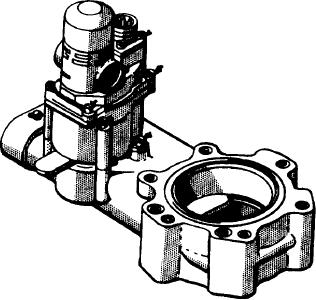
pounds passing to the engine is subtracted
from the original reading. Thus, the fuel counter
continually shows the total quantity of fuel (in
pounds) remaining in the aircraft. However, there
are certain conditions that cause the fuel counter
indication to be inaccurate. Any fuel remaining
in the droppable tanks when they are jettisoned
is indicated on the fuel counter as fuel still
available for use. Any fuel that leaks from a tank
or a fuel line upstream of the flowmeter is not
counted. Any fuel supplied to the engine by the
emergency pump is not counted.
Some continuous-flow fuel systems have a fuel
quantity gauge for each tank or group of inter-
connected tanks. If the system has a main tank
with auxiliary tanks feeding into it, a fuel quantity
gauge is normally for the main tank. In this type
of system, the pilot relies on the indication of the
fuel counter (flowmeter). All fuel in the auxiliary
Figure 4-10.-Motor-operated shutoff valve (gate valve).
tanks is transferred to the main tank and fed to
the engine. When all fuel except that in the main
tank has been consumed, the fuel quantity gauge
Fuel Level Control Valves.-- Fuel level
provides a more reliable indication of the fuel still
control valves control fuel levels in a tank during
available. The accuracy of its indication is not
ground fueling or fuel transfer to the main tank.
affected by the conditions listed in the preceding
There is one fuel level control valve for each tank,
paragraph; that is, leakage and emergency system
auxiliary tank, or group of interconnected tanks.
supply.
When used for fuel transfer, the valves are located
The fuel quantity gauge normally used in air-
at different levels in the main tank. Fuel is then
craft is an electronic (capacitor) type for measur-
transferred from the auxiliary tanks in the order
ing fuel in aircraft in pounds. Normally, the
designed by the manufacturer. During normal
capacitor-type fuel gauge is used without a
operation of the fuel system, the boost pumps for
flowmeter, although most engines have provisions
all the tanks are turned on before the engine is
for installing one if it is required,
started. Each auxiliary tank boost pump continues
A low-level switch is incorporated in the fuel-
to operate until the tank is emptied; then the fuel
level transmitter. This switch turns on an indicator
pressure warning light comes on and the boost
light in the cockpit when the fuel in the tank drops
pump is turned off by the pilot. Thus, fuel is
to a specific low level. This signal informs the pilot
delivered under boost pump pressure to each fuel
that the fuel supply is almost exhausted.
level control valve. The fuel then remains in the
tank or group of tanks to which it is connected.
AIRCRAFT FUEL VALVES.-- Valves are
In the sectional views of the valve in
used to regulate and control the flow of fuel in
figure 4-11, note how the float rises and lowers
the airframe and engine fuel systems. Some of
with the fuel level. When the fuel level in the main
these valves are discussed in the following
tank is high, the float is raised. This closes the
paragraphs.
pilot valve and lifts the ball check from its seat.
Fuel, under boost pump pressure, then passes
through the main valve stem into the valve body.
Shutoff Valves.-- Shutoff valves are two-
Note how the fuel pressure exerted against the
position (open and closed) valves. The manually
operated type is installed to shut off the fuel while
bottom surface of the synthetic rubber diaphragm
holds the main valve closed. This prevents fuel
a unit in the system is being removed or replaced.
Electrically operated shutoff valves control flow
from entering the main tank from the transfer
line.
during fuel transfer and when fuel is being by-
When the fuel level in the main tank drops,
passed because of a defective or damaged unit.
the float moves downward. Note in figure 4-11
Figure 4-10 shows a motor-operated shutoff valve,
how this action allows the ball check to seat in
commonly referred to as a gate valve.
4-16

